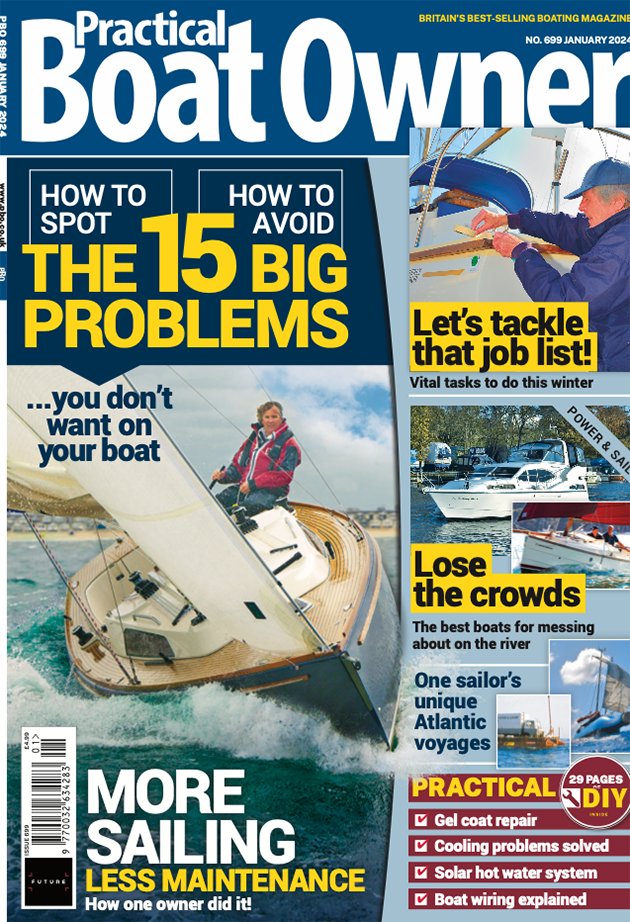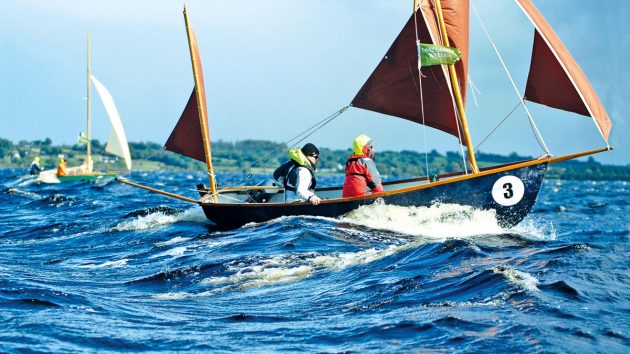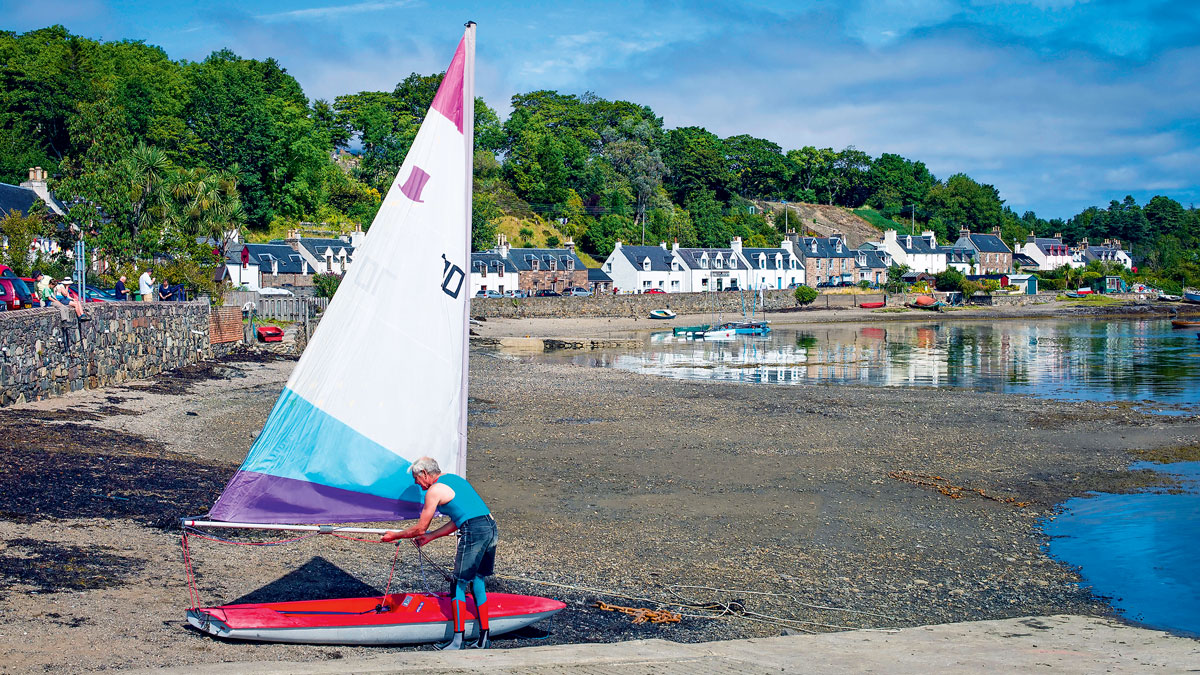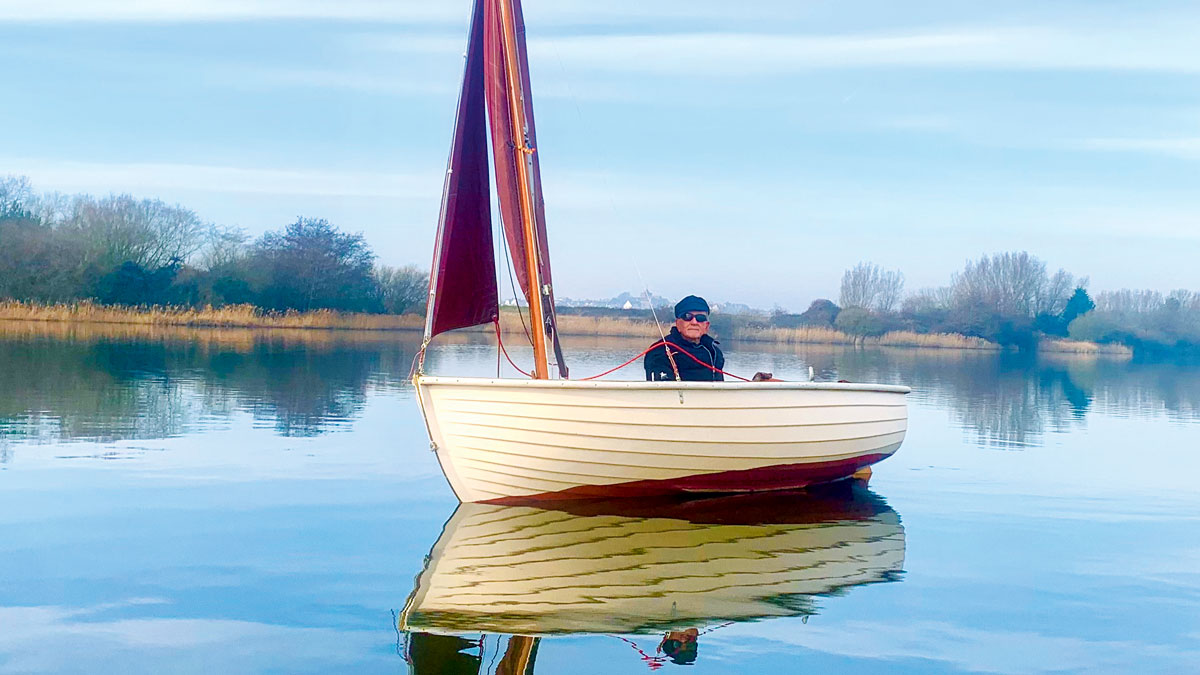Why the correct manoeuvres for the sea conditions will reduce hogging and sagging stress on both ship and crew
The problem with sailing in waves is that they may be the wrong length for your vessel.
For example, a 1,000ft container vessel might find that very long waves cause stress on her keel which is not fully supported evenly. A hogging or sagging stress may occur and fractures caused by this type of wave have been blamed for the sudden disappearance of many large vessels.
However, the same very long waves may cause no problems at all for our little boats while we happily ride up and down them.
I say happily, but this may not relate to an unfortunate crew suffering motion or sea sickness.

Dabbers can handle most conditions under motor, sail or oar
Hogging is the name given to stress on a ship’s keel and hull that can cause the centre of the keel to bend upward when the forward and aft ends of the ship are not supported.
Sagging is the stress on a ship’s hull or keel when waves are a similar length to the ship’s hull causing the ship to be in the trough of two waves.
This may cause the middle of the ship to bend down slightly and may also cause the hull to fracture.
Smaller but short, steep waves may cause all sorts of problems for a little boat but would go unnoticed by a container vessel.
Sailing in waves: Stress reduction
My favourite little ship for crossing the northern Atlantic was the Beaverash, a general cargo vessel of just 4,529 gross registered tons with a top speed of 14 knots down wave.
One winter we passed Cunard’s famous original Queen Elizabeth of 83,673 gross tons, nearly 20 times our size and three times our length.
She was crawling along or lying hove to and looking most uncomfortable.
She could do an amazing 32.5 knots if she wanted but the waves were just the wrong length for her hull at that time or for her passengers’ comfort and the captain had taken this action to reduce stress on both his ship and her passengers.
Our chief officer, John, had previously been third mate on the Queen Elizabeth and we attempted to communicate with his chums on her bridge as we steamed passed on our merry way up and down the huge long waves.
On another occasion, the Queen Elizabeth was steaming towards us at great speed and we were struggling to keep our prop in the water with the wrong sort of waves.

Beaverash, a little ship that coped well with most waves
John told me to call them up for a chat using the Aldis lamp but they simply flashed their funnel illumination lights on and off a few times, they were far too busy to waste time socialising with a little freighter, much to John’s displeasure.
More often than not things were not at all comfortable for us!
When the waves became shorter our prop would leave the water and the resultant vibration was tooth rattling.
Under these circumstances, we’d batten down and hove to or do whatever we could to counter the wrong sort of waves.
At one time or another, we will all encounter the wrong sort of waves for our little ships. The same principles apply to all my little boats.
Continues below…
Spritsails, snotters and leeboards
There’s a lot to be said for owning small boats and chartering big ones...Clive Marsh looks at spritsails, snotters and…
Sailing surfboats: Lasers, the Lightning 368 and more!
Clive Marsh looks at sailing surfboats - the Seabat, Minisprint, Lightning 368 and more!
Tideway 10: Gunter or Lugger?
The trailerable Tideway 10 has the benefits of her sister vessel, the Tideway 12, but is lighter and easier to…
Lifeboat and working boat conversions
The basic shape of a traditional lifeboat is a long shallow keel, double ended and beamy – ideal for conversion…
For example, my past fin-keeled Westerly Cirrus was 22ft LOA (19ft LWL) and had an uncomfortable corkscrew motion in waves of a certain length and height which made going below a real challenge if prone to seasickness.
My clever bilge-keeled Corribee, meanwhile, which was a tad shorter than the Cirrus, had no such corkscrewing problems.
But her propeller would leave the water in short waves, unlike the Cirrus’s prop which, being an inboard, was lower down and further forward.
I’d imagine a fin-keeled Corribee with an inboard engine would give an all-round better ride but then it can’t be beached without the burden of legs.
The constant compromises required by boats fit for their purpose is probably the reason why I’ve owned more than 50 of them to meet my constantly changing requirements.
Well good
My Drascombe boats all had outboard motor wells and the props seldom left the water being sited further forward.
With their lifting centreplates they were easy to beach too. It’s hard to fault Drascombe or Devon Luggers and Dabbers under motor, sail or oar.
Their designer, John Watkinson, got it right first time.

Drascombe Dabber Uaithne at rest – on the island of Oronsay on Loch Sunart near Mull. Credit: Nicola Campbell/Alamy
The boats I own are small and tough for their size and are unlikely to be bothered with hogging or sagging – the main concern is keeping the prop in the water when encountering the wrong sort of waves.
This is especially the case with outboard motors.
Generally, I’ve found that my purpose-built motor boats such as Orkneys are very good.
The worst offenders for props leaving the water are little yachts with an outboard motor hanging off a raised transom, like the aforementioned Corribee with its beautiful, long, overhanging transom which is useless for mounting an outboard motor.

Clive’s Orkney Longliner whose outboard prop seldom left the water
For this reason, some Corribee owners have fitted small inboard engines.
Sailing dinghies with transom-hung outboards may find the engine gets in the way of both rudder and main sheet and tends to leave the water in short waves.
In fact, I now only mount the outboard on my dinghies when the rudder is removed and the sea is not too lumpy.
Most of the time they’re not a lot of use and can cause more trouble than they are worth.
But having no outboard ready can be a problem when entering some harbours or tight spaces with commercial traffic.
For example, the entrance to Rye, with fast flowing tides, is very narrow and it’s possible to lose the wind and steerage when sheltered by the wall or high land at the entrance.
As commercial traffic makes way through this tight-fit channel, drifting about is a problem for all.
For this reason, I like boats with an engine well so I can keep the outboard easily ready while maintaining sail.
Careful timing
One potential problem for lightweight boats with a low rig in high waves is a loss of wind in the troughs.
The waves might be comfortable (not too short) but they might shelter a low rig from the wind causing a loss of steerage and a possible broach.
Changing course may require careful timing.
Knowing how to cope with different wave conditions and to take advantage of them is a skill that I’m still learning – knowing how your boat will cope with different waves comes only after using it for some time.
Just a few weeks ago I sat on Winchelsea beach in a storm watching the awesome waves and surf crashing when a young fella and his girlfriend (with mobile signal) came along to launch a windsurfer.
Clearly an expert, he waited his moment and launched into the cauldron, somehow avoiding the nasty underwater hazards along that beach.
It was an impressive display as he disappeared completely between the troughs.
However, he soon came back on the crest of a wave.
I asked him if he enjoyed it and he said yes, but the trouble was the wind kept pausing!
Enjoyed reading Sailing in waves in little boats? 
A subscription to Practical Boat Owner magazine costs around 40% less than the cover price.
Print and digital editions are available through Magazines Direct – where you can also find the latest deals.
PBO is packed with information to help you get the most from boat ownership – whether sail or power.
-
-
-
- Take your DIY skills to the next level with trusted advice on boat maintenance and repairs
- Impartial in-depth gear reviews
- Practical cruising tips for making the most of your time afloat
-
-
Follow us on Facebook, Instagram, TikTok and Twitter








